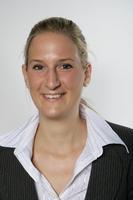The unique combination of Naída's nonlinear frequency compression (SoundRecover), PowerProcessing, and BassBoost provides an extraordinary level of audibility and clarity. In addition to the Naída UltraPower (UP) hearing instrument, designed for profound to severe hearing loss, the Naída SuperPower (SP) completes Phonak's innovative product range in the high power segment by providing a pioneering digital solution. Naída SP offers the opportunity to fit moderately-severe to profound hearing losses including those with a sloping configuration. SoundRecover is designed to offer better auditory perception of high-frequency signals, which is particularly important for speech intelligibility. The goal is that, as a result of the improved audibility of high-frequency signals provided by SoundRecover, consonants such as /s/, /f/, and /sh/ can be successfully heard, identified, and differentiated. Results from field testing with the new Naída family of hearing devices yielded high spontaneous acceptance and a particularly positive evaluation of sound quality despite additional high range information applied in the audible range. A significant advantage of Naída V UP with SoundRecover with regard to speech clarity as compared to three products from other manufacturers was demonstrated in the Freiburg monosyllable test in a quiet environment and the Oldenburg sentence test in a noisy environment. The improved perception of high-frequency signals was objectively verified by measuring aided thresholds.
Introduction
Naída is the new line of water-resistant Phonak Behind-the-Ear hearing instruments for individuals with severe to profound hearing loss. Naída is based on Phonak's latest wireless chip technology, the CORE platform, and provides new features, such as SoundRecover, WhistleBlock, wireless programming, QuickSync, and Bluetooth connectivity. The unique combination of SoundRecover, PowerProcessing, and BassBoost provides an extraordinary level of audibility and clarity. SoundRecover is designed to make high-frequency signals audible, which is particularly important for speech intelligibility and many environmental sounds. The goal of improved audibility of high-frequency signals provided by SoundRecover is that consonants such as /s/, /f/, /sh/ can be successfully heard, identified, and differentiated. This innovative, nonlinear algorithm for frequency compression compresses and shifts selected high-frequency signals into a lower frequency range in which audibility is better. As a result, the audible range is increased without creating disruptive artifacts and while ensuring good sound quality. Frequencies below the frequency compression kneepoint are amplified by the hearing system normally. The initial frequency compression setting is automatically calculated for each user by Phonak's iPFG fitting software. The SoundRecover nonlinear algorithm was developed and verified in Australia by Dr. Hugh McDermott, on the basis of extensive clinical tests involving individuals with moderately-severe to profound hearing losses (Simpson, Hersbach & McDermott, 2005, 2006). Additional comprehensive field studies were performed over the past four years with adults and children in Australia, Canada, Germany and Switzerland, confirming the numerous advantages of SoundRecover.
Test persons and hearing systems
The following study was performed at the Phonak Hearing Center in Stafa, Switzerland, to systematically evaluate the benefits of a nonlinear frequency compression algorithm on speech intelligibility. Eleven test persons (5 female and 6 male participants) between the ages of 41 and 79 (average age of 56.3) participated in the study. All participants had a profound hearing loss (see Fig. 1) and were provided with binaural hearing aids. All participants had been wearing hearing aids for more than 6 years.
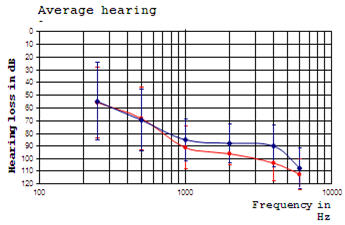
Figure 1. Average air conduction thresholds of the 11 test persons (blue = left;red = right).
The new Phonak hearing instrument Naída (model Naida V UP) was tested in comparison with three competitive instruments (referred to as A, B and C) designed for wearers with profound hearing loss. The competitor products were selected on the basis of their wide market distribution. All devices were fit according to the manufacturer recommendations. A precalculation with the same acclimatization level and a feedback test was performed for all four hearing aids and two manual programs (one with the omni microphone mode and one with directional microphone mode) were set. Since one of the competitor products did not have a directional microphone, the omnidirectional microphone mode was used.
Method
Subjective and objective measuring procedures were used in this study. Subjective evaluations included various questionnaires to determine the spontaneous acceptance of the Naída devices in different environments. Objective measures included comparison of speech intelligibility between Naída and the competitor products using the Freiburg monosyllable test (Hahlbrock, 1953;von Wedel, 1986) in a quiet environment, and the Oldenburg sentence test (OLSA) (Wagener, Brand & Kollmeier, 1999a, 1999b;Wagener & Kollmeier, 2004;Wagener, Kuehnel & Kollmeier, 1999) in a noisy environment.
Speech intelligibility in a quiet environment - Freiburg monosyllable test
The Freiburg monosyllable test was selected due to its frequent use in German-speaking countries. The 20 monosyllable words per test row were played through a speaker (0° azimuth, at head height) at a distance of 1 m from the test participant. The Freiburg monosyllable test was measured at an output level of 50, 65, and 80 dB HL.
Speech intelligibility in a noisy environment - Oldenburg sentence test
Speech intelligibility in a noisy environment was assessed by the OLSA. The OLSA is an adaptive test that measures intelligibility in a noisy environment of short sentences consisting of 5 words with following structure: Name - verb - number - adjective - object. The participants are instructed to repeat the sentences or words that were understood. The participants sat in the middle of a circle of speakers and were instructed to face the front speaker (0° azimuth) that provided the speech signal. Cafeteria noise with the same duration as the speech material was played constantly at 65 dB(A) on 5 speakers (head height) at 60°, 120°,180°, 240°, and 300° (see Fig. 2). In contrast to the constant noise, the speech signal was varied according to a standardized adaptive method. This test measures the speech reception threshold (SRT:signal-to-noise ratio for 50% speech intelligibility) and provides the result in dB as the signal-to-noise ratio (SNR) at this threshold.
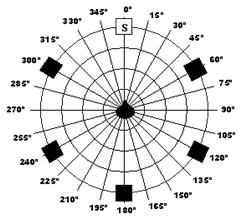
Figure 2. Test setup for measuring the OLSA. S = speech signal;black boxes emit the noise
Aided threshold
The improved audibility of high-frequency sinusoid tones was shown on the basis of an aided threshold. In this case, the aided threshold is a measurement of the hearing threshold with hearing aids via a free field speaker. Sinusoid tones were emitted via a speaker (head height) at a distance of 1 m from the test person. Immeasurable frequencies were set at "125 dB" and taken into account in the audiogram.
Results
In addition to very good spontaneous acceptance of loudness (90% reported that the volume was "just right"), sound quality (80% reported that the sound was "very pleasant", 20% reported the sound to be "good (OK)") and evaluation of own voice (80% reported the sound of their own voice to be "optimal"), the audiologists judged the subjects' speech intelligibility in the first conversation to be very good.
Comparison of speech intelligibility between Naída V UP and competitor products
The results of the Freiburg speech test (Fig. 3) show a clear increase in speech clarity with Naída compared to the competitor products. All hearing aids were set for the omni microphone mode. Improvement is observed primarily at a quiet speech level (17.5% improvement at 50 dB HL) and a normal speech level (17.5%-40% at 65 dB HL). The difference between Naída and hearing aid A is significant for both speech levels (Wilcoxon paired t-test => 50 dB HL: p
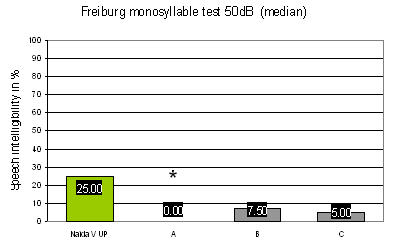
Figure 3. Average results (median) in Freiburg monosyllable test for Naída V UP and the three competitor products at 50 dB HL. *p
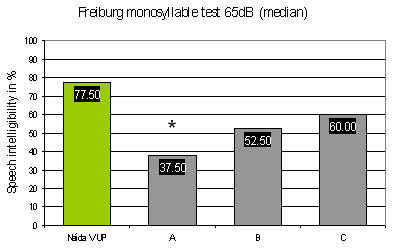
Figure 4. Average results (median) in Freiburg monosyllable test for Naída V UP and the three competitor products at 65 dB HL. *p
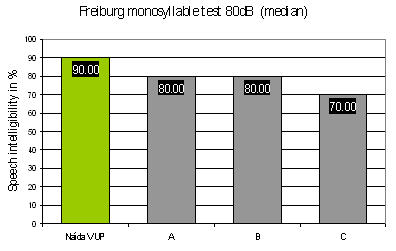
Figure 5. Average results (median) in Freiburg monosyllable test for Naída V UP and the three competitor products at 80 dB HL.
The test results (Fig.6) of the speech intelligibility test in a noisy environment show a significant advantage and improved speech intelligibility with the Naída instruments in the "speech in noise" program with microphone mode dAZ (digital AudioZoom). Compared to the competitor products with a directional microphone, Naída achieved a significant improvement of 6.22 dB Signal-to-Noise Ratio (SNR) (HG A;p
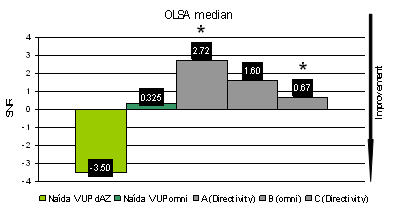
Figure 6. Average results (median) for the Oldenburg sentence test for Naída V UP and the three competitor products in a noisy environment (constant 65 dB HL). *p
Improved audibility of high frequencies
With Naída, improved audibility is expected above 2 kHz since the lowest frequency for nonlinear frequency compression is 1.5 kHz. The improved audibility of high-frequency sinusoid tones (above 2 kHz) was shown on the basis of an aided threshold for Naída with SoundRecover "on" compared to Naída with SoundRecover "off". SoundRecover "off" in Naída UP corresponds to targets of the Phonak precalculation without the effect of the SoundRecover algorithm.
Depending on the particular frequency compression setting and the individual audiogram, measurements have shown aided thresholds between 3-6 kHz achieve an average improvement of up to 25 dB while no difference was measured between SoundRecover "on" or "off" below 2 kHz. On average, a 15 dB improvement was achieved at 4 kHz with SoundRecover "on" compared to SoundRecover "off". At 6 kHz for one test person the improvement was as large as 25 dB. For one test subject, thresholds at 6kHz could not be measured with SoundRecover "off". Therefore, a measurement point was set at 125 dB HL. In contrast to SoundRecover "off", a threshold improvement of 75 dB at 6kHz was measured in the SoundRecover "on" setting for this test subject, which resulted in a free field hearing threshold of 50 dB HL.
Summary
The present study demonstrated that Naída V UP with the SoundRecover nonlinear frequency compression algorithm provided a significant, measurable advantage for speech intelligibility in both a quiet and a noisy environment as compared with three different competitor products. This was attributed to the improved perception of high-frequency speech components provided by SoundRecover.
References
Hahlbrock, K.H. (1953). Über Sprachaudiometrie und neue Wörterteste. Arch Ohren Nasen Kehlkopfheilkd 162:394-431.
Simpson, A., Hersbach, A.A., McDermott, H.J. (2005). Improvements in speech perception with an experimental nonlinear frequency compression hearing device. IJA 44(5):281-292.
Simpson, A., Hersbach, A.A., McDermott, H.J. (2006). Frequency-compression outcomes in listeners with steeply sloping audiograms. IJA 45(11):619-629.
von Wedel, H. (2006). Untersuchungen zum Freiburger Sprachtest - Vergleichbarkeit der Gruppen im Hinblick auf Diagnose und Rehabilitation (Hörgeräteanpassung und Hörtraining). Audiol Akustik 25:60-73.
Wagener, K., Brand, T., Kollmeier, B. (1999a). Development and evaluation of a German sentence test - Part II: Optimization of the Oldenburg sentence test. Zeitschrift für Audiologie 38: 86-95.
Wagener, K., Brand, T., Kollmeier, B. (1999b). Development and evaluation of a German sentence test- Part III: Evaluation of the Oldenburg sentence test. Zeitschrift für Audiologie 38:86-95.
Wagener, K., Kollmeier, B. (2004). Göttinger und Oldenburger Satztest. Zeitschrift für Audiologie 43:134-141.
Wagener, K., Kuehnel, V., Kollmeier, B. (1999). Development and evaluation of a German sentence test- Part I: Design of the Oldenburg sentence test. Zeitschrift für Audiologie 38:86-95.
 Author: Dr. Myriel Nyffeler is Head of the Field Studies at Phonak AG in Stäfa, Switzerland and is responsible for all hearing instrument field studies. Dr. Nyffeler earned her doctorate degree in the field of Neurobiology at the Swiss Federal Institute of Technology (ETH).
Author: Dr. Myriel Nyffeler is Head of the Field Studies at Phonak AG in Stäfa, Switzerland and is responsible for all hearing instrument field studies. Dr. Nyffeler earned her doctorate degree in the field of Neurobiology at the Swiss Federal Institute of Technology (ETH).

